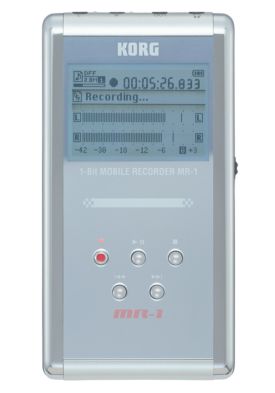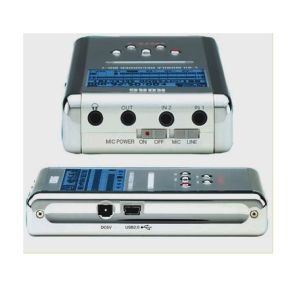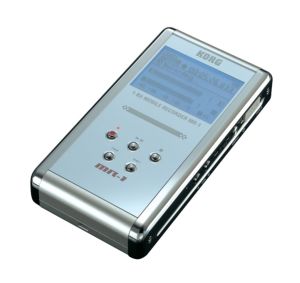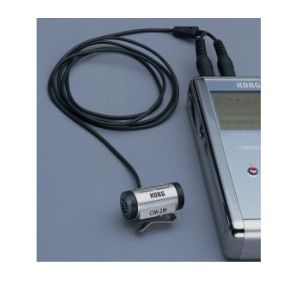
Korg MR-1 Review First ImpressionsThe Korg MR-1 looks and feels like a shinier, smoother, sexier version of most of the other handheld recorders available. Palm-sized, but with a solid feel. It comes with an AC adapter, usb cable, cover, stereo mic, clip to hold the mic, an owner's manual and a CD rom with AudioGate editing software. The buttons are small, precise and clearly marked. The screen is relatively large, but somewhat low in contrast. The build quality is very handsome. Ease of UseIf you are comfortable with the file/menu computer interface, the Korg MR-1 is easy to use. The manual is a relatively quick read, but I made my first recording without it. Navigation is performed via a menu button and pushable p-dial, both of which feel solid enough to withstand the wear and tear of regular use. The MR-1 records in wav and dff formats. DFF is a 1-bit audio file format used in professional audio devices for SACD (Super Audio CD) production. To record in dff format, you simply select the format from the menu and press "record." Basic editing of the dff files can be accomplished with the AudioGate software. AudioGate was easy and uneventful to install - almost as intuitive to use as the recorder itself. Only time will tell if the hype behind Korg's 1-Bit, "future-proof" technology actually proves valid.  Storage and ConnectivityThe Korg MR-1 has a huge 20GB hard drive. Note that it is indeed a hard drive and not solid state. The manual spends a bit of ink instructing the owner not to bump it, drop it, or make any fast moves while playing with it.
They mean it. When I removed the USB cable a bit too quickly for its liking (after going through the "safely remove hardware" drill on my pc), it seized up and gave me a few "Fatal Error" and "Disk Error" messages. It wouldn't shut down during the fatal error episode. To recover, I had to wait for the battery to drain and then reboot with the AC adaptor. To be fair, this episode only happened once, during the very first week of use. Since then, there have been no hard drive problems. The MR-1 has stereo mini jacks for headphone, line input and output. It has 2 mono mic inputs - one each for the left and right channels. This means you'll need a Y-adapter if you want to use an external mic that has a single stereo mini-jack connection. The MR-1 USB 2.0 connection is quick and responsive. Battery LifeThe Korg MR-1 has an internal lithium-ion battery. Like the MicroTrack, the battery cannot be changed by the user. When it no longer takes a charge, it must be sent back to Korg or your dealer to be changed. This is not ideal. It is also a bit puzzling given that it's big brother, the MR-1000, accepts AA batteries. The Korg MR-1 finished dead last in our recent battery life test . We were able to record for 2 hours and 43 minutes on one charge. Of course, you may achieve different results. We think the Audio Technica AT822 sounds good with the Korg MR-1. Of course, the AT822 is not the only stereo mic that will work, but it's a well-made, AA battery-powered, solid-performing stereo mic that comes with cables that are compatible with the separate Left and Right mono mini jack outputs of the MR-1. If you already own the AT822, the MR-1 could be worth your serious consideration. UPDATE: Initially, we raved about the MR-1's sound quality, but after using it for a few months, we changed our minds. Compared to the other gadgets we carry, it sounded dry and clinical. We received a lot of feedback that our first samples sounded incredibly bad and noisy. The old sample was made with Korg's included CM-2M microphone, with the MR-1 recording levels set at 0.00 gain. Korg Customer Service suggested setting the gain to -10.0 or -15.0 in order to get rid of the noise and bad sound. The result? Slightly less like "fingernails on chalkboard" than the old one, but it still lacked depth and had a faint "hum" in the background. Despite trying many other settings on the MR-1, we could never completely eliminate the noise. We suspect that the problem is due to the relatively low quality of the CM-2M microphone and self-noise from the MR-1 hard drive, but this is mere speculation on our part.  Conclusion (Revised)The Korg MR-1 is a very good-looking and easy-to-use portable recorder. With a 20GB hard drive and a relatively weak internal lithium-ion battery that cannot be replaced by the consumer, it is not the most robust or convenient portable recorder you could choose. However, the MR-1 could be one of your better-sounding alternatives if you use a microphone better than the included Korg CM-2M.
|
